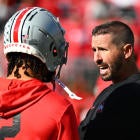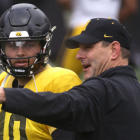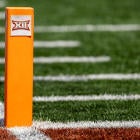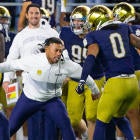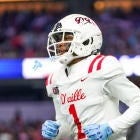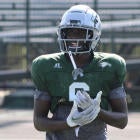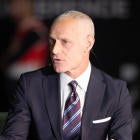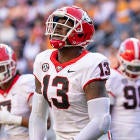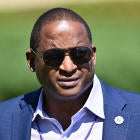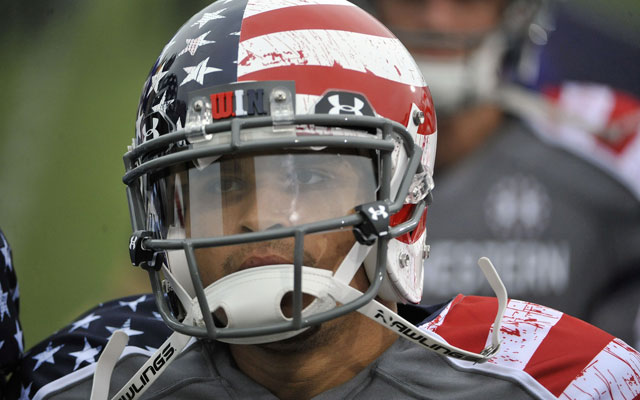
PHILADELPHIA -- Former Northwestern quarterback Kain Colter grew frustrated looking at those congregated inside an auditorium last week to discuss college athletes' rights. It’s not who was there that bothered Colter; it’s who wasn’t present -- active athletes.
Ramogi Huma, who helped Colter organize the failed 2014 attempt to unionize Northwestern football players, sat on stage with Colter during one panel. So did Pulitzer Prize-winning author Taylor Branch, whose 2011 article in The Atlantic describing the college players’ fight as a civil rights issue opened the eyes of NCAA issues to a broader audience.
In the crowd listening to Colter was Dr. Harry Edwards, a sociologist who helped organize the Black Power salute by Tommie Smith and John Carlos in the 1968 Summer Olympics. Lawyers, academicians, media members, professors and students mostly made up the audience at the College Athletes' Rights & Empowerment (CARE) conference.
In the days that followed at the conference last week, longtime NCAA critic Sonny Vaccaro -- best known as a longtime sports marketing executive who signed Michael Jordan to Nike -- ranted about a system that caused him to organize the Ed O’Bannon lawsuit. Former college basketball player Luke Bonner talked about athletes’ fear of their coaches’ power. Ex-Texas women’s athletic director Donna Lopiano and economist Andrew Zimbalist debated two economic professors about whether Congress should get involved with the NCAA.
All of that was fine and good. But in the search for the next Kain Colter, it became apparent there aren’t many Kain Colters even listening.
“It’s a little disappointing when you come to events like this and we don’t have any current athletes,” said Colter, now a Los Angeles Rams wide receiver. “This is who we need to get the message to. It’s great we’re talking to everybody here, but the players themselves aren’t here. So how can we expect them to step up if they don’t even know what’s going on?”
The college athletes’ rights movement has stalled. That doesn’t mean it’s going away. Progress has been made incrementally, and at times (though not often), the NCAA and schools acknowledge they've made changes because of external pressures. But there’s growing frustration that chipping away isn’t enough and active athletes need to be better educated in order to rise up.
The O’Bannon lawsuit brought the players an antitrust victory and helped force the NCAA to adopt cost of attendance stipends to players. But the allowance of $5,000 per year to players after they graduate got overturned by the Ninth Circuit, whose ruling created a tougher hurdle for the Jeffrey Kessler lawsuit to gain a free market for players to get paid. The O’Bannon lawyers have petitioned the Supreme Court -- they’re risking $42.3 million in awarded legal fees if they lose -- and the NCAA will likely petition as well.
No single message of what to do next emerged from last week’s athletes’ rights conference. There was plenty of debate, which was the point of the exercise. But reformers continue to be splintered into different areas based on their skill sets, beliefs and interests. Among the divided issues:
• How much should the Black Lives Matter theme be included in efforts to give football and men’s basketball players more rights? That’s especially relevant after Missouri football players held a boycott last season to support a student's hunger strike over perceived racial discrimination on their campus. Increasingly, some reformers believe a players’ strike is the only way to get real NCAA change and that those efforts need to focus on race given how many blacks play the highest-profile sports and their lower graduation rates.
• Should some reformers continue to champion as much as they are for football and men’s basketball players to be paid? Some people within the movement say that could be detrimental to non-revenue athletes and view the rhetoric as a divisive approach sure to fail.
• Is it best to negotiate a conditional antitrust exemption now through Congress that would prevent pay-for-play but allow other benefits for players? Or is it better to let the courts play out the free-market approach from pending antitrust cases against the NCAA?
• More importantly: Who’s the next Colter? No one scared the people who run college sports quite like Colter. He was an active, intelligent and respected college athlete with direct access to his locker room to educate teammates on ways he believes they are exploited. Efforts are being made to potentially find high school players and parents to challenge the NCAA.
As Colter expressed his frustration while speaking on a panel, Edwards reminded him it only takes one black athlete -- like Muhammad Ali, Bill Russell and Jim Brown many years ago -- to produce the internal revolt Edwards believes is needed to change the NCAA. But right now, Edwards told Colter, the college athletes’ rights movement lacks messaging that mobilizes players to its core beliefs.
“At Northwestern, the message was great,” Colter told Edwards. “We almost had 100 percent buy-in. The problem is the coaches have access. I’m not there anymore. We can’t deliver this message every day. The coach hears about the message, decides to shoot it down, decides to call every player’s parents and say, ‘Hey, get your kid to vote against the union.’”
Edwards looked at Colter and smiled. “Well, brother, that’s why they call it a struggle rather than a picnic. … One day, just as sure as we’re sitting here, they’re going to get the message and all of a sudden you’re going to have teams at the Final Four say, ‘Hey, we’ll take the floor. Just as soon as we talk about the union and the money.’”
Racial dynamics of fighting for money
You can’t escape the money in college sports. Last week in Philadelphia, they played NCAA Tournament games to determine a Final Four participant. CBS and Turner will reportedly pay the NCAA $11 billion over 14 years for the rights to televise the wildly popular tournament.
It’s an example of an industry flooded with money that the NCAA restricts the players from accessing in the name of amateurism. Increasingly, some people in the public get the argument made by those who wants players paid and with a stronger voice. Still, it’s a hard sell because many fans view the chance for a free education as appropriate compensation for playing. NCAA critics point out that pockets of athletes aren’t being educated, as evidenced by academic fraud scandals at Final Four schools North Carolina and Syracuse.
I asked several North Carolina, Notre Dame, Wisconsin and Indiana players what they know about the issues being discussed at the CARE conference. Needless to say, most of them understandably don’t understand the intricacies of what academicians talked about to themselves in a vacuum over three days last week.
But if you simply ask players whether they think they should get paid, they get it. Many of them generally understand why some people say they're being exploited.
“It’s hard to answer that because there’s so many factors that go into that,” said North Carolina guard Marcus Paige, an academic All-American. “But when you see the amount of money that this tournament makes and the coaches make and the people running this stuff make. I think the ACC is making for our four teams’ success in the Elite Eight, they’re making $30-$40 million extra.
“Um, I mean, I think a little cut wouldn’t be too bad. I just think the system is a little bit antiquated, and if they could find a way to more fairly compensate the players for their part -- whether that’s paying them or just changing the rules a little bit -- I think it would be beneficial. But it’s hard to change such a long-standing, traditional thing like the NCAA.”
This is what the NCAA banks on. Make some changes to the system -- the NCAA now allows benefits such as cost of attendance stipends and unlimited meals -- and then hold some other improvements in the back pocket for future use if needed. Some of these changes help ensure players’ rights don't appear that bad to the masses, which are too young/disinterested to follow (many players) or just want to be entertained (most fans).
Oklahoma athletic director Joe Castiglione said people act surprised when college athletes take stances on issues these days. "I say, 'Shame on you,'" Castiglione said this week at the annual state of the NCAA news conference. "Maybe it's the first time you've noticed, but the student-athletes that I know have had a voice for as long as I've been in this business."
Players do have votes now in the NCAA system and some conferences even give athletes a vote. NCAA critics say there aren't not enough player votes to create a real voting bloc, especially since the needs and opinions of high-profile athletes can differ from non-revenue athletes. Oklahoma football player Ty Darlington, who has a vote in the Power Five autonomy structure, criticized the five major conferences for getting nothing significantly passed at this year's NCAA convention.
There is progress for the movement by the very fact that Branch, who won the Pulitzer Prize for a book on Martin Luther King Jr., appeared at the National Constitution Center last week to discuss why players’ rights are a civil rights issue. Yet even Branch sounds like he feels stalled.
“The biggest frustration that I’ve had since stumbling into this issue after writing civil rights history is people do not even want to hear the issue of rights,” Branch said. “They want to talk about fun and will the athlete study and what will happen to the volleyball players and how you design the full system. You don’t need to establish new rights. You need to return to the athletes the rights that have been stolen from them to represent themselves.”
But Branch isn’t anywhere remotely close to being on the radar of college athletes. No college players (or very few parents) are concerned about medical coverage during the recruiting process. They want to know how soon they’ll play in college and their chances of playing professionally.
Blacks comprise the vast majority of college basketball players. Edwards predicts that within six to eight years, there will be more blacks in football than in basketball due to concerns over concussions. “You’re going to tune into Alabama playing Ole Miss and it’s going to look like Ghana playing Nigeria because that is who is going to be playing the game,” he said.
Edwards said no amount of reason or condemnation about athletes being “used up” without an education and no professional career will change the NCAA, which he said is “deeply committed to its objective of making money.” What Edwards calls for is a revolt by players based on the broader, political dynamics of society.
“Our revenue-producing sports at the collegiate level are going to be more and more impacted by that racism,” Edwards said. “Why? Because they’re going to be overwhelmingly black kids involved -- young black kids about whom no one gives a damn. They’re villainized and criminalized by the general society and exploited in the revenue-producing sports at these major Division I campuses.”
These remarks got met with applause from the audience. For two days at the conference following Edwards' speech, his opinions about race and college sports got met approvingly by many other panelists and attendees. (They also got cited as divisive by some audience members.)
This is another reason why the college athletes’ rights movement has stalled.
No structure in the movement
Understand this about the efforts by outsiders to reform the NCAA: There has never been structure.
How could there be given the allure of opportunity and prestige that college athletics provides athletes, especially those from lower-income families? How could there be given judicial rulings through the years favoring the NCAA, the NCAA’s influence with Congress, and the NCAA’s mass-media messages to the public that its multibillion-dollar industry is first and foremost about education?
“They shove it down your throat, they burp ya and they give you water to drink it down,” Vaccaro, the former shoe marketer, crudely said of the NCAA’s commercials. “That’s what they do, and by the time the water goes down and you go to the bathroom three hours later, you think it’s a clean story. It’s not.”
Think of the college athletes’ rights movement like a political party -- except without a formal mechanism to create a unified party platform. The NCAA, at least, has a president who serves as the human piñata for unpopular membership decisions and a governance structure through various committees that yield votes.
You can’t even identify one person in the athletes' rights movement and definitively say, “There, that’s the leader.” That can be both a strength (more ways to attack the system) and a weakness (very few coordinated plans).
Huma’s National College Players Association claims more than 17,000 athletes have joined its organization. “It’s not a homogenous group,” Huma said. “You don’t have a Kain Colter at a lot of places. You don’t have the guys at Missouri at a lot of places.”
Even the NCPA’s positions can differ from other prominent people in the movement. So the fights get splintered among lawyers, professors, media members, economists and the occasional ex-athletes and current players. They get fought by firebrands who want to push the envelope with scorched-earth rhetoric and by moderates who seek compromise through incremental gains.
The movement’s biggest weakness is it has very limited access to current players. Drexel professor Ellen Staurowsky, who organized the CARE conference, said she sent invitations to 125 athletic directors at schools along the East Coast requesting their attendance along with that of their athletes and coaches.
She doesn’t know if the invite reached any athletes. During one conference session, a speaker asked the audience how many current college athletes were in attendance. One Division III men’s basketball player raised his hand.
“We can talk about this stuff until we’re blue in the face: ‘We’re moving the needle, we’re moving the needle, we’re moving the needle,’” said Bonner, a former West Virginia and UMass basketball player whose brother Matt Bonner plays in the NBA. “We need a freaking current player that’s active to do something -- another Kain Colter.”
Bonner said one way to find the next Colter is for pro athletes to “stop being such wimps” and talk honestly about their experiences so it motivates and provides cover for active college players.
“We all believe the players need a fairer system, but my brother’s not up here talking about anything,” Bonner said. “Why would he? He’s got his own life going on. A lot of players feel the same way, but how are you going to get them to disrupt their lives by dealing with criticism by being here? They’re millionaires.”
The backlash of fighting the system is a player can be accused by the public of being pampered and ungrateful given that the average American has to pay off student loans from college. Lopiano, the former women’s athletic director at Texas who is fighting for NCAA reform, said college athletes already receive more fully-funded, non-repayable aid from their universities than any other student, including national merit scholars.
“Add the training tables, add nutrition, add everything else, I don't think you can set up a minor league team that provides that type of money,” Lopiano said.
To those who say athletes should be grateful for what they have, Bonner said, “Well, you should have been up at 6 in the morning every morning doing dribbling drills. You should have grown 7 feet tall. Sorry, you didn’t.”
Many ex-athletes who do speak out say they can’t emphasize enough how real the power is that coaches hold over their players.
“I’m 30 years old. I published my first article for Vice (about my experiences as a college athlete),” Bonner said. “It was very even-keeled and honest. When I got published, I was in my office like shaking and sweating like scared out of my mind. How could I? 'Oh, Coach is going to ... I don't know what he’s going to do. He’s going to make me run.' You’re talking about the most powerful individuals in every state essentially is the head coach. They make you have this feeling of like they made you.”
Should Congress get involved?
Within the movement, one of the most contentious debates is whether to negotiate a conditional antitrust exemption for the NCAA in exchange for other benefits. An exemption could remove the legal challenges the NCAA continues to face in court over its rules.
If Congress got involved, it’s possible a commission could be created to study players’ rights issues and require changes in exchange for a conditional exemption. But there’s deep skepticism within parts of the movement that Congress would do anything but help the NCAA, which appears to view Congress as a last-ditch effort if necessary.
New York Times columnist Joe Nocera said he has documents showing the NCAA’s general counsel saying that if amateurism rules are seriously in jeopardy under antitrust law, the NCAA’s athletic directors, coaches and universities would go to Congress to pass an exemption for the NCAA. A high-ranking administrator in major college sports echoed the same sentiment to CBS Sports, saying that the NCAA believes it can get an exemption immediately if the courts allow players to be paid.
The NCAA spent $1 million on lobbyists in 2014 and 2015, according to records listed on opensecrets.org. That’s far less than the NFL spent those two years ($2.4 million), but the NCAA’s two-year total exceeded its lobbying total from 2008-13 ($990,000). The NCPA, the most structured organization in the athletes' rights movement, spent $26,582 on lobbying efforts in 2014, according to the NCPA's 2014 tax form.
NCAA president Mark Emmert said there is not a plan “right now” to go before Congress. “But at some point it may well be we wind up with a case in front of the Supreme Court to ascertain what the ultimate state of the law is and what the Supreme Court thinks that collegiate sports should look like in America,” Emmert said from the Final Four this week. “Then we’ll see where that goes.”
Within some circles among administrators in college sports, there’s a belief the NCAA wants a seminal moment to wake up Congress and get a swift, definitive and favorable answer on antitrust law as legal fees from court cases continue to rise. In other words, such a moment could be a players’ strike or a Supreme Court decision against the NCAA.
“Congress will get involved if there’s a judicially-imposed solution,” said Zimbalist, a prominent economics professor at Smith College. “They’re not just going to let it stand. … A judge-imposed solution or a legal settlement is not a democratic resolution of the problem. It’s an arbitrary solution among the people in the room when the case is heard.”
So Zimbalist and Lopiano are pushing for reform through an antitrust exemption with conditions. Critics push back and are fearful of giving the NCAA any sort of immunity. In a way, the debate within the movement hinges on who you trust more, Congress or judges.
Last June, four members of Congress reintroduced legislation to create a Presidential Commission of Intercollegiate Athletics to address health and safety, scholarship lengths and due process for athletes. The legislation, which was silent on whether athletes would be allowed to get paid, hasn’t gotten much traction in Congress.
Zimbalist said athletes shouldn’t get a salary for playing but should be allowed to earn anything else related to their talent. Conditions would also include proper medical care and disability insurance for athletes, he explained.
At one point last week, Staurowsky, the organizer of the conference, told Zimbalist that his remarks sounded like “talking points” for the NCAA. He took exception to the criticism. Nocera said an antitrust exemption is a “terrible idea” and has called for a salary cap for players. Zimbalist countered that a salary cap isn’t possible unless it’s collectively bargained by a union, and there’s no sign of player unions anytime soon given the National Labor Relations Board decision in the Northwestern case.
If players could be paid by schools, Lopiano and Zimbalist question how colleges would protect their tax preferences, such as tax-free bonds and an 80-percent reduction in booster contributions, and keep the rest of their athletic department afloat. Yes, cuts in coaches’ salaries and facilities could be made over the long term, they argued, but likely not in the short term and that could cause even more use of university subsidies to cover deficits.
Lopiano said a for-profit business would make college sports “a minor league,” to which several audience members remarked in unison, “They already are,” citing how many classes basketball players miss during the season, especially during the postseason tournaments.
There are other conflicts within the movement related to focusing on football and men’s basketball players. Several times at last week’s conference, attorney Paul McDonald made a pitch that reform efforts need to involve all college athletes.
McDonald brought a lawsuit against the NCAA and more than 100 Division I schools alleging that the NCAA’s limits on compensation for sports violate the wage-and-hour provisions of the Fair Labor Standards Act. A federal judge recently dismissed the federal suit filed in Indianapolis, and McDonald is appealing that decision.
At one point during the conference, McDonald suggested his case hasn’t gotten much attention because it’s not a “sexy” topic and he’s “not a lawyer who has a big name.” Branch, the civil rights author, told McDonald it’s his job to get more publicity for “a very worthy case.”
During another panel, there was a tense exchange in which McDonald, who is black, said, “When we allow people to say it’s a black issue, we allow them to marginalize it. My point is if you want more people involved, you have to make them comfortable that it’s not just a black issue.”
Vaccaro, who has fought against the NCAA for years, stood up and addressed McDonald.
“There is only one issue,” Vaccaro began. “The cartel (the NCAA) is as powerful as a kingdom. It is Downton Abbey. We just won’t accept it. What you’re saying is pure. You look at this thing as 'Isn’t this perfect'? Well, it’s pretty for the guys who are swimming, the guys who are doing fencing, the guys who are getting the free ride. Why (are revenue-producing athletes) paying for them to get a free ride?”
Christine Berk, a former Maryland field hockey and lacrosse player, listened to the debate and advised that too much of the discussion has become “divisive” by pitting athletes against one another.
“If you’re going to go forward with these types of plans, you’re going to need every athlete on board,” Berk said. “I think what’s often forgotten is, as athletes, we just want to play, even to this day. The thing we were most terrified about as student-athletes was the coaches. It wasn’t the NCAA. It wasn’t the administration. It was our coaches, who had total control of how often we played, whether we sat on the bench, how injuries were handled and how we were talked to and how we were treated.”
Bonner, the former basketball player, told Berk that the efforts don’t want to marginalize non-revenue sports. He pointed out that a friend, who is a Duke women’s lacrosse player, almost got suspended for starting a lacrosse camp to raise money.
“We’re focusing on football and basketball, but part of the narrative is if it’s logical to treat the sports the same,” Bonner said. “I don’t know.”
Searching high school ranks for next Colter
So, where do you find the next Kain Colter?
Increasingly, some efforts are being made to locate high school players to challenge the NCAA system. The thinking is reformers need to get in front of AAU basketball teams and 7-on-7 football camps. Going to these events could allow them to outline to recruits and their parents what rights they have while they enjoy leverage before signing with a school.
Yet even these attempts are very unstructured. Privately, some former college players who are part of the movement are frustrated that there’s not a mobilization strategy to get the message out to players. Instead of being asked by movement leaders to visit summer camps, the ex-players said they volunteer to do it with no real plan to get boots on the ground.
Vaccaro, who organized the O’Bannon lawsuit against the NCAA in 2009, believes there could be a firestorm coming if the NBA requires players to spend at least two years in college, not one. Vaccaro said he has talked with the families of five elite basketball recruits who view themselves as potential one-and-done players, and plans to meet with them this summer.
“The parents are upset,” Vaccaro said. “You’re sitting out two years (from the NBA) for what? They see the money in college sports. It’s not like they’re giving the money to charity. They’re giving it to the coach recruiting their son. The reason these shoe companies are signing the whole AAU team is they probably have one or two guys who could be superstars.
"The mindset of the parents now is, ‘Why can’t we just get the $100,000? We’ll support our own team.’ That’s the logical question. Well, if you do, the player is ineligible due to NCAA rules.”
Richard Southall, director of the College Sport Research Institute at the University of South Carolina, compared the delay in activity within the players’ rights movement to presidential politics.
“People expect things to happen in a reality-TV format,” he said. “So you have the introduction, conflict, conclusion and the denouement, and it hasn’t happened that way exactly as either side (the NCAA or players' rights movement) would want it. So it’s not easy or neat or clean. It’s like you’re in third gear. Do you go to fourth or go back to second?”
We're now asking who’s the next Kain Colter, but the question once was who would be the first active athletes in court cases demanding players be paid. Five football players -- Vanderbilt’s Chase Garnham, Clemson’s Darius Robinson, Arizona’s Jake Fischer and Jake Smith, and Minnesota’s Moses Alipate -- added their names to the O’Bannon case in 2013.
Then in the Kessler lawsuit, which seeks a free market for players, Clemson football player Martin Jenkins, Wisconsin basketball player Nigel Hayes, Middle Tennessee football player Anfornee Stewart, Rutgers basketball player J.J. Moore, UTEP football player Kevin Perry and Cal football player Bill Tyndall attached their names to it in 2014.
What’s next? No one can predict for sure. And that's why it’s frustrating for Colter, who wants to attend conferences and see athletes engaged so they have voice and leverage separate from the NCAA.
“I just want to be on the right side of history," Colter said.












